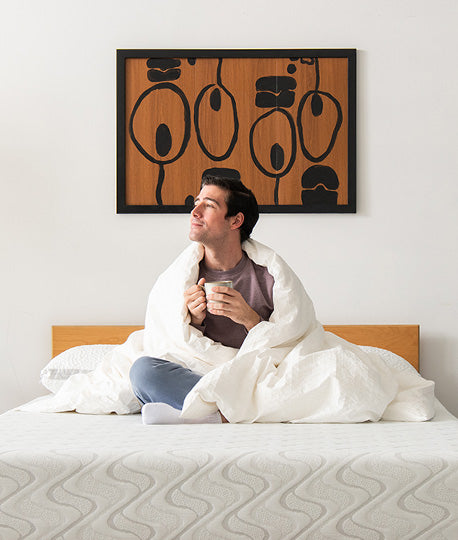How to Layer Your Bed for Winter Without Waking Up in a Sweat

There's nothing quite like climbing into a cozy bed on a cold winter night until you wake up at 3 AM feeling like you're sleeping in a sauna. If you've ever found yourself trapped in the frustrating cycle of being too cold with minimal blankets and too hot once you pile them on, you're not alone.
The secret to comfortable winter sleep isn't about choosing between freezing or overheating; it's about building a smart layering system that keeps you warm while letting your body breathe. By understanding which materials work best and how to arrange them properly, you can create a sleep environment that adapts to your body's changing temperature throughout the night, saving money on heating bills while getting the restful sleep you deserve.
Start with the Foundation: Your Mattress Pad
The bottom layer of your winter bed setup matters more than most people realize. A quality mattress topper or pad serves as insulation between you and the mattress, preventing heat loss from below while you sleep. Memory foam toppers work particularly well because they contour to your body, regulate temperature, and they trap warmth without creating the stuffy, overheated feeling that comes from less breathable materials.
When selecting a mattress pad, look for options that balance warmth with moisture-wicking properties. Our mattress protectors are designed to add a layer of comfort while allowing air circulation, preventing that clammy feeling that disrupts sleep. The key is finding something that provides cushioning and insulation without creating a heat trap. If you tend to sleep hot, consider a thinner pad with cooling properties rather than a thick, plush topper that might retain too much body heat.
Choose Your Sheets Wisely
Your sheet selection makes a significant difference in how well your layering system performs. For winter, heavier cotton sheets or flannel fitted sheets create a warm base that feels comfortable against your skin. Flannel and brushed cotton have a soft, fuzzy texture that traps air and provides immediate warmth when you first get into bed.
That said, breathability remains important even in winter. Organic cotton and percale sheets offer excellent temperature regulation because they allow moisture to evaporate rather than trapping it against your skin. We offer several sheet sets made from high-quality cotton that work beautifully year-round, including options with higher thread counts that provide extra softness without sacrificing breathability.
The goal is to create warmth without creating a moisture barrier that leads to that sweaty, uncomfortable feeling in the middle of the night.
Build the Middle Layers
This is where layering strategy really matters. After your fitted sheet, add a flat sheet as your next layer. While some people skip the flat sheet, it serves an important purpose in a layered bed: creating a buffer between your body and heavier blankets, making it easier to adjust your temperature by simply moving this single layer.
Next comes your primary warmth layer, typically a duvet, comforter, or quilt. Down and down-alternative comforters provide excellent insulation while remaining relatively lightweight. Down has natural temperature-regulating properties and breathes well, making it less likely to cause overheating compared to synthetic materials that trap moisture. If you prefer a down alternative for allergy or ethical reasons, look for high-quality options that mimic down's breathability.
Our comforters are designed with temperature regulation in mind, offering warmth without excessive weight. A medium to heavy-weight comforter works well for most winter sleepers, but if you run hot, consider a lighter weight option and add an extra blanket layer that you can easily remove.
Add a Removable Top Layer
The final layer should be easy to add or remove without messing up your whole bed. A lightweight throw or coverlet at the foot of the bed or folded across the middle gives instant temperature control. If you feel chilly when you first get in, pull it up. If you wake up feeling too warm, push it down toward your feet without having to remake the bed.
Wool blankets are perfect for this because they naturally regulate temperature and wick away moisture. They are warm but still let air circulate, so you avoid the stuffy feeling of synthetic fleece. Keep this top layer within easy reach. That is what makes a layered bed actually work instead of just looking nice.
The Art of Quick Adjustments
The whole point of layering is to give yourself options throughout the night without major disruption. Arrange your layers so the easiest one to remove is on top, not stuck in the middle where you would have to wrestle with the entire bed to adjust it. Keep your throw blanket loose rather than tucked in, so you can kick it off easily if you get too warm.
For couples with different temperature preferences, consider separate top layers. You can share the fitted sheet, flat sheet, and main comforter, but each person can have their own throw or extra layer. This prevents nightly thermostat battles and helps both people sleep comfortably. Some customers have had success using a lighter comforter with individual blankets, giving each person complete control over their warmth.
Choosing Materials That Won't Break the Bank
You don’t need to replace your entire bedding collection to create an effective layering system. Start with what you have and figure out the gaps. If you’re using only a heavy comforter, add a quality sheet set and a throw blanket. If your sheets are thin summer-weight cotton, consider flannel sheets, or keep your current sheets and focus on improving the middle and top layers.
For a budget-friendly approach, start with versatile pieces. A quality duvet with a removable, washable cover gives you flexibility. You can change the cover’s weight seasonally while keeping the same insert. Our duvet covers come in different materials and weights, letting you adjust your bed’s warmth without buying all-new bedding.
When you’re ready to invest in premium pieces, focus on items that touch your skin (sheets and pillowcases) and your main warmth layer (comforter or duvet). These have the biggest impact on comfort and sleep quality. A high-quality cotton sheet set and a well-made comforter will last for years, making them a smart investment that pays off in better sleep every night.
The Financial Case for Layering
Properly layered bedding can genuinely help lower your heating costs. When you’re comfortable sleeping in a cooler room, usually between 60 and 67 degrees Fahrenheit, you can turn down your thermostat by a few degrees at night. Dropping it just three degrees for eight hours each night can save around 10% on your heating bill, which really adds up over the winter.
Most people notice improved comfort within the first few nights of layering their bedding. Your body adjusts to the cooler room, and being able to fine-tune your warmth means fewer sleep disruptions. Quality bedding also lasts longer than cheap alternatives, so your investment keeps paying off for years. A well-made comforter or sheet set can easily last five to ten years with proper care, making the per-night cost surprisingly low.
Avoiding Common Overheating Mistakes
Even with the right layers, certain mistakes can sabotage your comfort. The most common error is using too many heavy layers at once. More blankets do not automatically equal better sleep. They can create excessive heat buildup and trap moisture against your skin. Instead of piling on multiple thick blankets, use fewer layers made from materials that naturally regulate temperature.
Another mistake is neglecting room ventilation. Even in winter, your bedroom needs some air circulation. Stuffy, stagnant air contributes to overheating and poor sleep quality. Crack a window slightly or run a fan on low to keep air moving without making the room uncomfortably cold.
Pay attention to your bedding materials. Synthetic fabrics like polyester fleece trap heat and moisture, creating that clammy, overheated feeling. Natural materials such as cotton, wool, and down breathe better and wick moisture away from your body. If you wake up sweaty despite having what seems like a reasonable amount of bedding, your materials might be the problem rather than the number of layers.
Watch for warning signs that your setup is not working. If you consistently wake up too hot or too cold, or adjust your layers multiple times each night, something needs to change. Experiment with removing or adding a single layer, or try swapping a synthetic blanket for a natural fiber option. Small adjustments can make a significant difference in your comfort level.
Creating Your Perfect Winter Sleep Environment
Building an effective layered bed takes a little experimentation, but the payoff in comfort and sleep quality is worth it. Start with a breathable mattress pad, add quality sheets suited for winter temperatures, layer on a temperature-regulating comforter, and finish with an easily removable top blanket. Position everything for quick adjustments, and don’t be afraid to tweak your setup as temperatures change throughout the season.
The beauty of a properly layered bed is its flexibility. You are not locked into a single configuration. You can adapt to the weather, your body’s needs on any given night, and even differences with a sleeping partner. By investing in quality materials and arranging them thoughtfully, you create a sleep environment that keeps you comfortable all winter without overheating or turning up the thermostat.
Explore our site to explore sheet sets, comforters, and bedding accessories designed to help you build the perfect winter sleep setup. Your best night’s sleep is just a few layers away.




